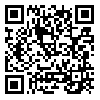Volume 72, Issue 8 (November 2014)
Tehran Univ Med J 2014, 72(8): 533-539 |
Back to browse issues page
Download citation:
BibTeX | RIS | EndNote | Medlars | ProCite | Reference Manager | RefWorks
Send citation to:



BibTeX | RIS | EndNote | Medlars | ProCite | Reference Manager | RefWorks
Send citation to:
Emamgholizadeh Minaei S, Mozdarani H, Aghamiri S M R, Motazakker M, Mansouri M. Cytokinesis blocked micronucleus assay for evaluation of chromosomal breaks in esophageal cancer . Tehran Univ Med J 2014; 72 (8) :533-539
URL: http://tumj.tums.ac.ir/article-1-6345-en.html
URL: http://tumj.tums.ac.ir/article-1-6345-en.html
Soraya Emamgholizadeh Minaei1 
 , Hossein Mozdarani *
, Hossein Mozdarani * 
 2, Seyed Mahmoud Reza Aghamiri3
2, Seyed Mahmoud Reza Aghamiri3 
 , Morteza Motazakker4
, Morteza Motazakker4 
 , Mohsen Mansouri5
, Mohsen Mansouri5 


 , Hossein Mozdarani *
, Hossein Mozdarani * 
 2, Seyed Mahmoud Reza Aghamiri3
2, Seyed Mahmoud Reza Aghamiri3 
 , Morteza Motazakker4
, Morteza Motazakker4 
 , Mohsen Mansouri5
, Mohsen Mansouri5 

1- Department of Radiobiology and Radiation Protection, Shahid Beheshti University of Medical Sciences, Tehran, Iran.
2- Department of Medical Genetics, Faculty of Medical Sciences, Tarbiat Modares University, Tehran, Iran. ,mozdarah@modares.ac.ir
3- Department of Nuclear Physics, Faculty of Nuclear Engineering, Shahid Beheshti University of Medical Sciences, Tehran, Iran.
4- Department of Clinical Virology, Faculty of Medicine, Urmia University of Medical Sciences, Urmia, Iran.
5- Department of Oncology and Radiotherapy, Omid Center, Urmia, Iran.
2- Department of Medical Genetics, Faculty of Medical Sciences, Tarbiat Modares University, Tehran, Iran. ,
3- Department of Nuclear Physics, Faculty of Nuclear Engineering, Shahid Beheshti University of Medical Sciences, Tehran, Iran.
4- Department of Clinical Virology, Faculty of Medicine, Urmia University of Medical Sciences, Urmia, Iran.
5- Department of Oncology and Radiotherapy, Omid Center, Urmia, Iran.
Abstract: (6275 Views)
Background: Radiotherapy can cause DNA damage in normal cells, misrepaired or unrepaired double strand breaks in DNA lead to chromosomal breaks. As a result patient experience early and late effects in normal tissue during and after radiotherapy. Cytogenetic techniques can be used as a cancer predictive assay because there is an association between chromosome abnormalities and the risk of developing cancer. Also it can assess patient's complications during the therapy. The aim of the present study was evaluation of the cytogenetic alteration in peripheral blood lymphocytes of esophageal cancer patients treated with radiotherapy.
Methods: The present study is an experimental and prospective research. It was done at radiotherapy department at Omid Center in Urmia from January to December 2012. Blood samples were obtained from 15 esophageal cancer patients, before (0 Gy), during (21.6 Gy), and after radiotherapy treatment (43.2 Gy). Blood samples were cultured in RPMI-1640 complete medium containing 1% phytohaemagglutinin and incubated in a CO2 incubator. Cytochalasin-B was added to the cultures at a final concentration of 5 µg/ml. Finally, harvesting, slide making, and analysis were performed according to standard procedures.
Results: This study consisted of 15 patients, including 7 men and 8 women from 55 to 84 years old (70.07±11.548). Results indicate that, in the middle of treatment the average frequency of micronuclei increased significantly compared with their concurrent pre-treatment samples (greater than four-fold). Also, an increase in chromosome damage (MN frequency) proportional increasing radiation doses at the end of treatment was observed (P=0.001).
Conclusion: Increasing in the MN frequency in the second and third stages is due to radiation effects. Thus, the use of the MN technique for assessing of the side effects in patients during the therapy is very helpful. Moreover, MN assay can be used as a predictive assay for detecting individuals (patient or healthy) with intrinsic radiosensitivity.
Type of Study: Original Article |
Send email to the article author
| Rights and permissions | |
 |
This work is licensed under a Creative Commons Attribution-NonCommercial 4.0 International License. |



